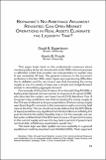Mostrar el registro sencillo del ítem
Bernanke's no-arbitrage argument revisited: can open market operations in real assets eliminate the liquidity trap?
| dc.contributor.author | Eggertsson, Gauti B. | |
| dc.contributor.author | Proulx, Kevin B. | |
| dc.date.accessioned | 2019-11-01T00:07:33Z | |
| dc.date.available | 2019-11-01T00:07:33Z | |
| dc.date.issued | 2016 | |
| dc.identifier.isbn | 978-956-7421-52-7 | |
| dc.identifier.uri | https://hdl.handle.net/20.500.12580/3849 | |
| dc.description | This paper looks back on the professional consensus about monetary policy at the zero bound prior to the 2008 crisis and proposes a calibrated model that provides one interpretation to explain why it was somewhat off base. The general consensus in the economics profession in the late 1990s when Japan was experiencing difficulties due to deflation and the zero bound was that increasing the money supply in one of a variety of ways was a simple and straightforward answer to stimulating aggregate demand. | |
| dc.format | ||
| dc.format.extent | Sección o Parte de un Documento | |
| dc.format.medium | p. 63-104 | |
| dc.language.iso | eng | |
| dc.publisher | Banco Central de Chile | |
| dc.relation.ispartof | Series on Central Banking Analysis and Economic Policies no. 24 | |
| dc.rights | Attribution-NonCommercial-NoDerivs 3.0 Chile | * |
| dc.rights.uri | http://creativecommons.org/licenses/by-nc-nd/3.0/cl/ | * |
| dc.subject | LIQUIDEZ (ECONOMÍA) | es_ES |
| dc.subject | POLÍTICA MONETARIA | es_ES |
| dc.subject | CRISIS ECONÓMICA 2008 | es_ES |
| dc.title | Bernanke's no-arbitrage argument revisited: can open market operations in real assets eliminate the liquidity trap? | |
| dc.type.doc | Artículo | |
| dc.file.name | BCCh-sbc-v24-p063_104 |


